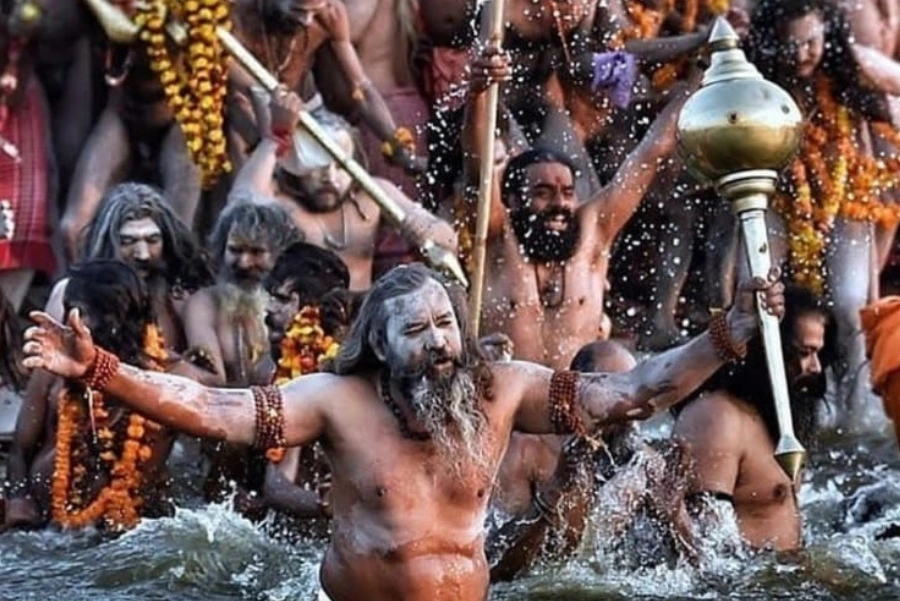Kumbh Mela in Prayagraj: The World’s Largest Spiritual Gathering. Kumbh Mela, attended every 12 times at four sacred spots in India, is the largest and the most important encyclopedically religious congregation on earth. Specifically, Prayagraj, formerly Allahabad, Kumbh Mela is the most sacred and the one attended by utmost pilgrims worldwide, with millions of pilgrims from over India and the rest of the globe. In this context, this grand spiritual circus deep in
1. Literal and Religious Significance
Spiritual Significance: Further, pilgrims think that the holy waters of Kumbh Mela purify the soul, wash away sins, and bring deliverance (moksha). In particular, Prayagraj, where Ganga, Yamuna, and fabulous Saraswati rivers converge at Triveni Sangam, is deified in particular for godly sanctity.
Ancient Origin: Kumbh Mela has its origins in Hindu tradition and dates back further than 2,000 years. Furthermore, it’s considered a celebration of the legendary churning of the ocean (Samudra Manthan), where the potable (amrit) was created. Based on this belief, droplets of the potable had trickled at four locations: Prayagraj (earlier Allahabad), Haridwar, Ujjain, and Nashik, and it is these that become sacred moments.
2. Kumbh Mela’s Timing and Cycle
– Also, the astrological alignment plays a pivotal part the Mela is entered grounded on specific celestial alignments, especially the positioning of Jupiter, the Sun, and the Moon. Accordingly, this is said to bring spiritual benefits to actors.
– Originally, the 12 Times Cycle Kumbh Mela takes the form of four megalopolis — Prayagraj, Haridwar, Ujjain, and Nashik. In this environment, the whole municipality conducts Mela in itself inclusively every 12 times, grounded on some specific astrological cycles.
– Also, Arth Kumbh Mela is distinct from a full cycle of 12 times. Specifically, Arth Kumbh Mela is done every 6 times in the Mecca of this Mela — Prayagraj.
3. The Magnitude of the Gathering
– Millions of Pilgrims: Kumbh Mela at Prayagraj attracts further than 100 million people during its period. It’s the largest mortal gathering in the world. Pilgrims come from different regions, languages, and societies to partake in this sacred event.
– A Harmonious Spirit: The Mela gives an occasion to a different set of people, across all strata of life, to come together beyond indigenous, artistic, and social differences. It’s a festival of faith, devotion, and the common spiritual trip.
Please read also: The Best of Turkey’s Ancient Ruins and Archaeological Sites
4. Important observances and Customs
– The Holy Dip( Snan): The most important ritual in the Kumbh Mela is the holy dip in the conduit at the Sangam. It’s believed that absorption in the waters of the Triveni Sangam will wash down all the sins and purify the soul.
– Processions and Bathing Schedules: various castes of addicts, including the deified Naga Sadhus, bathe on particular days of the astrological auspicious time. The peak days include Makar Sankranti, Mauni Amavasya, and Basant Panchami.
– Prayers and Immolations: Alongside the ritual bathing, addicts engage in prayers, contemplations, and immolations to seek blessings. Tabernacles are decorated with lights, and special prayers are held by religious leaders.
5. Naga Sadhus and Spiritual Leaders
– The Naga Sadhus: One of the most striking features of Kumbh Mela in Prayagraj is the Naga Sadhus — Cyrenaics who are devoted to spiritual practice and repudiation. These holy men are constantly seen participating in the procession and bathing first. As they are considered to be the holiest of addicts.
– Spiritual discourses: various spiritual practitioners and religious associations partake in the Mela through the provision of discourses, satsangs, and education. It’s an occasion for pilgrims to take over lower spiritual knowledge and reflection.
6. Cultural and Social Elements
– Exhibitions and Camps: In addition to the religious rituals, the Kumbh Mela also includes artistic exhibitions, temporary camps, and cells. Where people can learn further about Hindu traditions, rituals, and practices. Numerousnon-governmental associations( NGOs) and social groups also set up camps offering free food, medical help, and other services to the pilgrims.
– Music and Performances: The event is replete with spiritual music, bhajans, and kirtans. That reverberate through the air, enhancing the spiritual atmosphere. Colorful artists and players entertain the millions, keeping the energy alive and vibrant.
– Global Attendance: This is generally a Hindu jubilee. Kumbh Mela has appeal to the point of rubberneckers, devout crusaders, and addicts of every faith. So, it’s an experience as- culturally different as it’smulti-religious.
7. Contemporary structure and Safety
– Effective Arrangements: With the large crowd, the Prayagraj Kumbh Mela is strictly organized to insure the safety and well- being of the addicts. The government, along with original authorities, provides robust structure, including temporary covering, sanitation, medical installations, and transportation.
– Technology Integration: Technological integration analogous as digital shadowing and surveillance tools help control the crowd. The security arrangements are alternate to none, making it a safe terrain for pilgrims to walk on.
8. Environmental enterprises
– Sustainable Practices: With the same similar large crowds, environmental challenges arise, particularly concerning waste operation and the preservation of the sacred conduit waters. Organizers are fastening on promotingeco-friendly practices, similar as waste sequestration, plastic reduction, and conduit conservation enterprise.
– Swash Cleanliness perspires in order to save the chastity of the Triveni Sangam and girding waters, icing the ritual significance of the holy bath is n’t defeated.
Kumbh Mela in Prayagraj: The World’s Largest Spiritual Gathering
Zurich Unplugged: A 3-Day Itinerary for Discovering Hidden Gems and Quiet Charm


Pingback: South Korea’s Top Tourist Spots: Your Ultimate Travel Guide - Travelogy